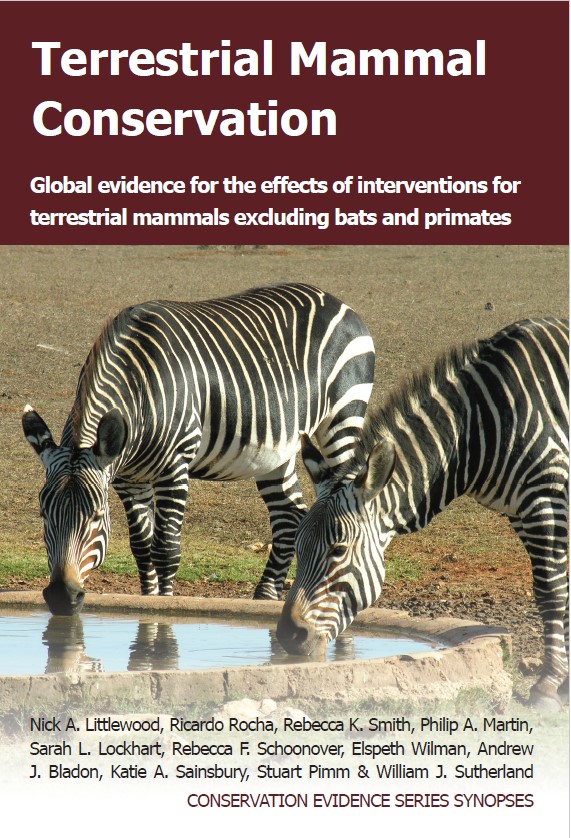Provide diversionary feeding for mammals to reduce nuisance behaviour and human-wildlife conflict
-
Overall effectiveness category Unknown effectiveness (limited evidence)
-
Number of studies: 3
View assessment score
Hide assessment score
How is the evidence assessed?
-
Effectiveness
60% -
Certainty
20% -
Harms
0%
Study locations
Supporting evidence from individual studies
A before-and-after study in 1981–1991 in an area of forest, residences and recreation facilities in Minnesota, USA (Rogers 2011) found that diversionary feeding reduced nuisance behaviour by black bears Ursus americanus. During eight years in which diversionary feeding was used, fewer bears (two bears) were removed for nuisance behaviour than in the three years before diversionary feeding started (six bears). Bears that visited the feeding site did not exhibit nuisance behaviour. A diversionary feeding site was operated during 1984–1991. This site was 0.25–3.4 km from a range of problem areas, including homes, a campground and a picnic site with unsecured bins and other food sources. The feeding location was stocked with beef fat and, sometimes, grapes. Bears were monitored using radio-tracking and direct observation and by ear tag returns from hunters.
Study and other actions testedA site comparison study in 1993-1998 in three regions comprising mainly forest and agricultural fields in Slovenia (Kavčič et al. 2015) found that providing diversionary feeding to reduce human-brown bear Ursus arctos conflict resulted in 22-63% of the estimated annual energy content of the diet of bears comprising supplementary food. Across the three regions, supplemental food was highest in the diet and was the most important food items in spring (maize: 27%; carrion: 26%), but not in summer (total 26%) and autumn (27%). The annual proportion of maize in the diet increased with the density of feeding sites (low density: 10-20%; high density: 52%). The proportion of all supplementary food in the diet followed a similar pattern (low density feeding sites: 22-33%; high density: 63%). In the three regions there was at least one carrion feeding site/60 km2 of bear habitat (annual estimate: 33-146 kg/km2) and maize feeding sites at average densities of one site/5.6 km2 of bear habitat (annual estimate: 70-280 kg/km2). Approximately two-thirds of feeding sites were supplied with food throughout the year. One region had a higher intensity of supplemental feeding (34 feeding sites/km2) than the other two (16 feeding sites/km2). A total of 714 brown bear scats were collected opportunistically (153-313/season, 220-260/region) from March to November 1993-1998 across the three regions and analysed.
Study and other actions testedA before-and-after and site comparison study in 2007 of 20 local communities in Lake Tahoe Basin, USA (Stringham & Bryant 2015) found that diversionary feeding of black bears Ursus americanus during a drought reduced human-bear conflicts, particularly in communities closest to feeding sites. Overall, the total number of human-bear conflicts/month was lower three months after diversionary feeding commenced (834) compared to one month before (1,819), although the difference was not tested for statistical significance (data reported in Stringham & Bryant 2016). Average daily declines in conflicts during the three months of feeding were greater at seven communities located 1 km from feeding sites (1.2%) than at three communities located ≥8 km from feeding sites (0.6%). Diversionary feeding was carried out in September–November 2007 after human-bear conflicts increased during a drought. Fruit and nuts were scattered over a 100 m2 area at 10 forest sites located 1–20 km from 20 communities. Human-bear conflicts (bears in yards, homes etc.) were reported to a telephone hotline in May–November 2007.
Stringham S. & Bryant, A. (2016) Commentary: Distance-dependent effectiveness of diversionary bear bait sites. Human–Wildlife Interactions, 10, 128–131.
Study and other actions tested
Where has this evidence come from?
List of journals searched by synopsis
All the journals searched for all synopses
This Action forms part of the Action Synopsis:
Terrestrial Mammal Conservation
Terrestrial Mammal Conservation - Published 2020
Terrestrial Mammal Conservation





)_2023.JPG)














